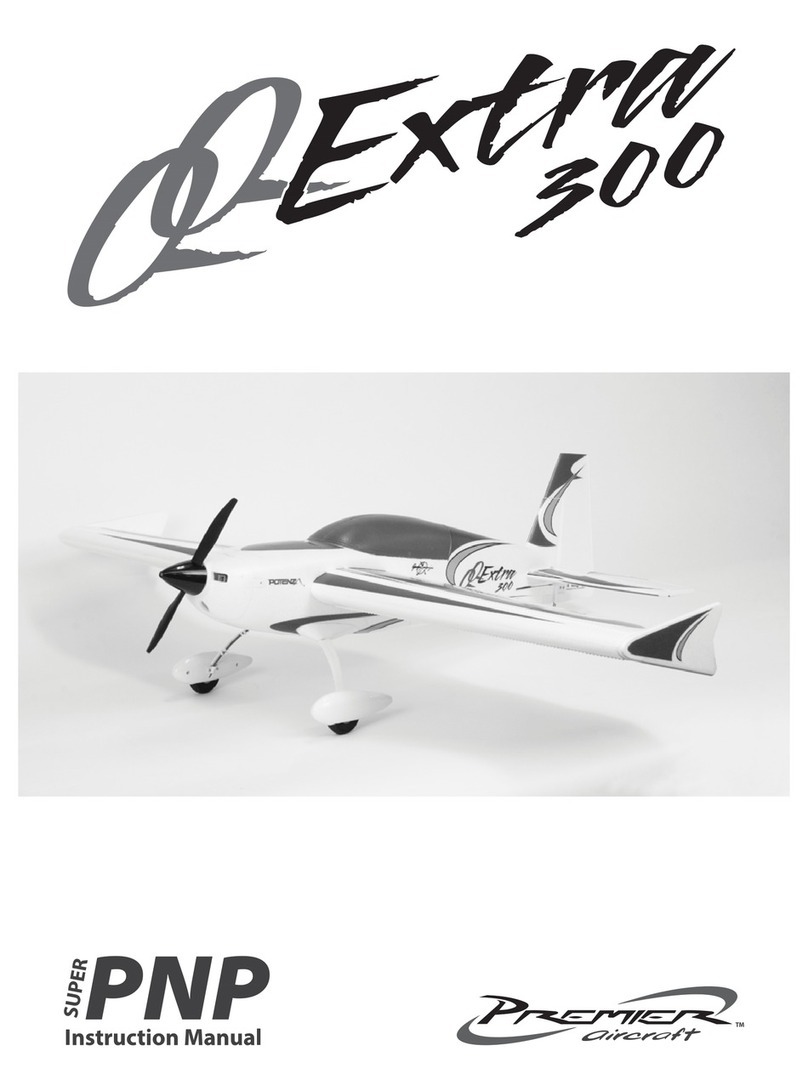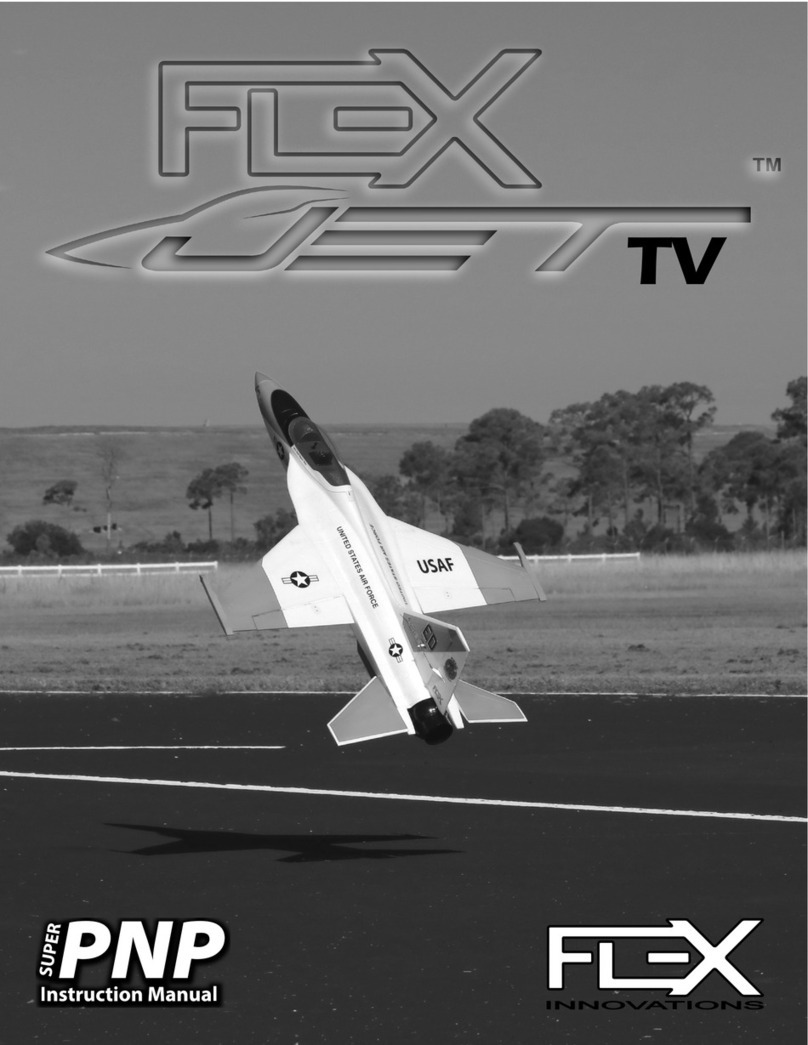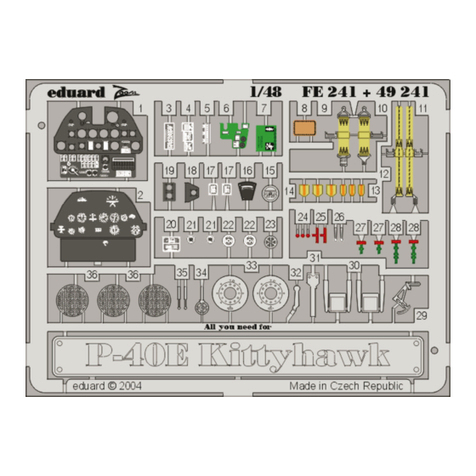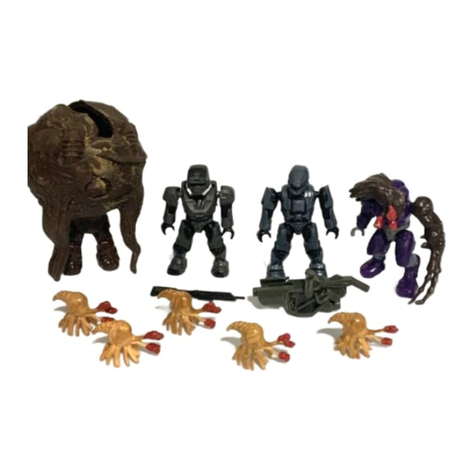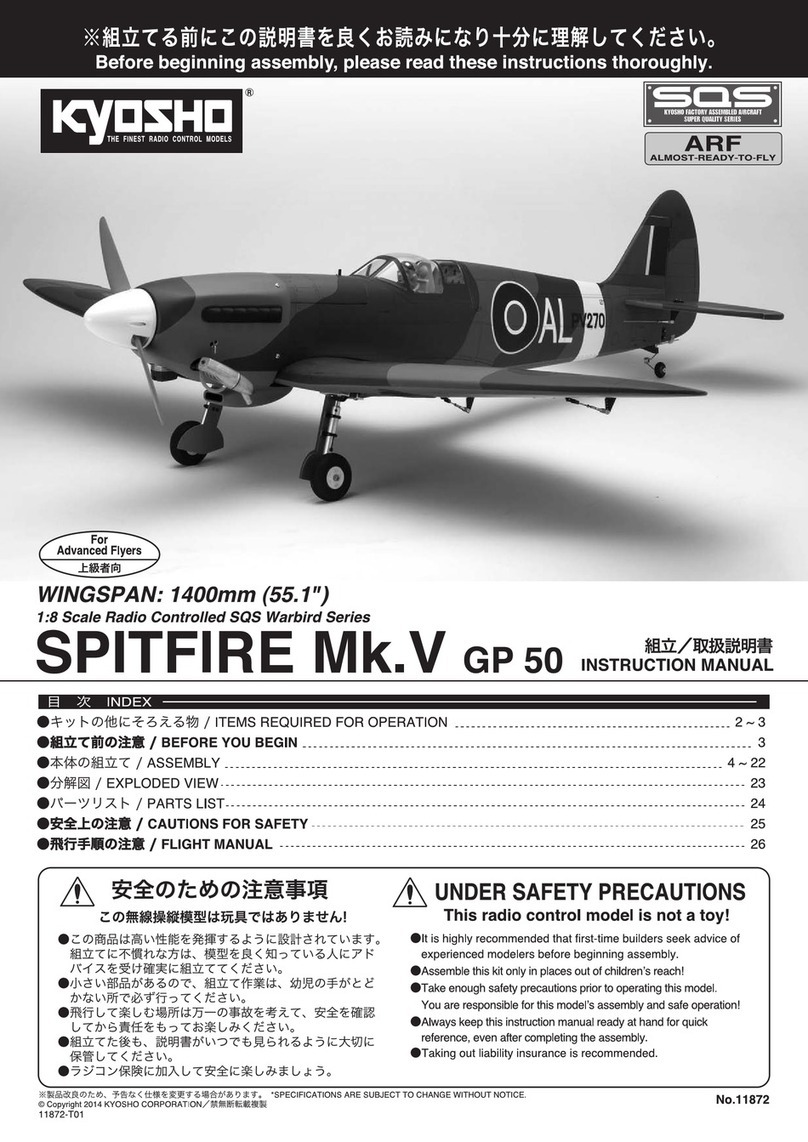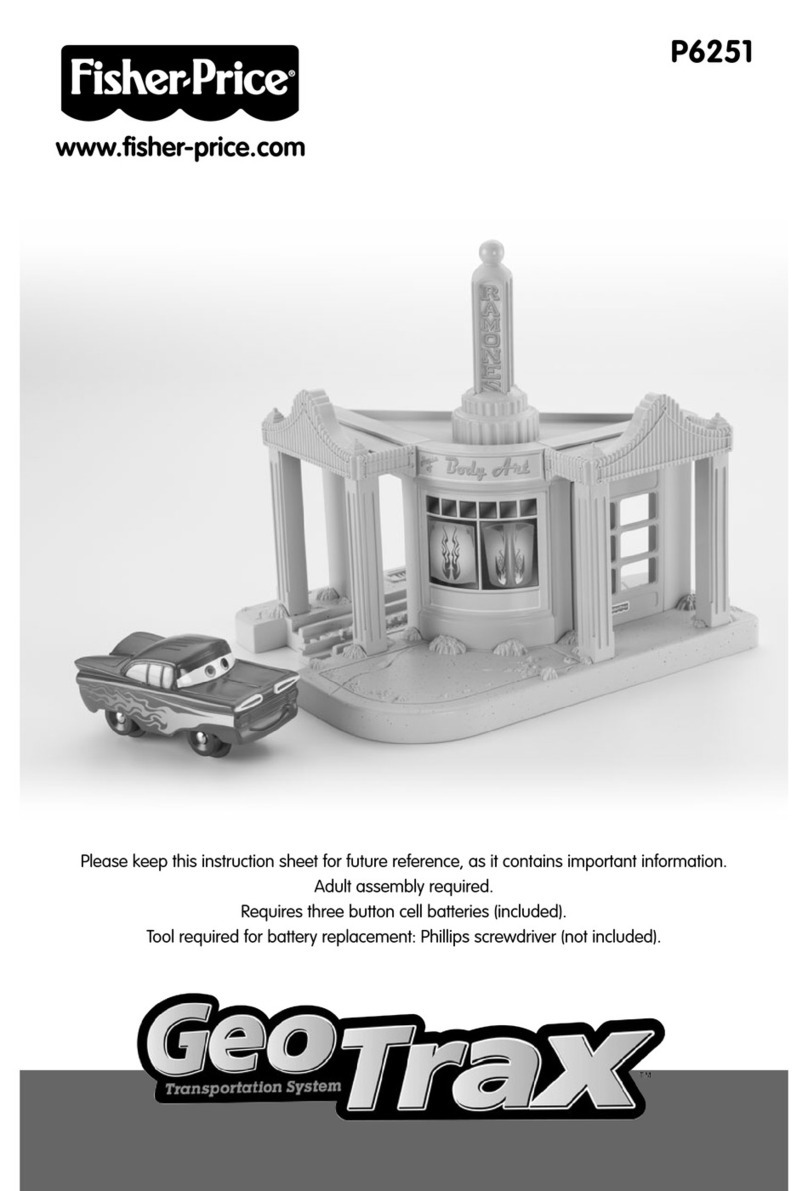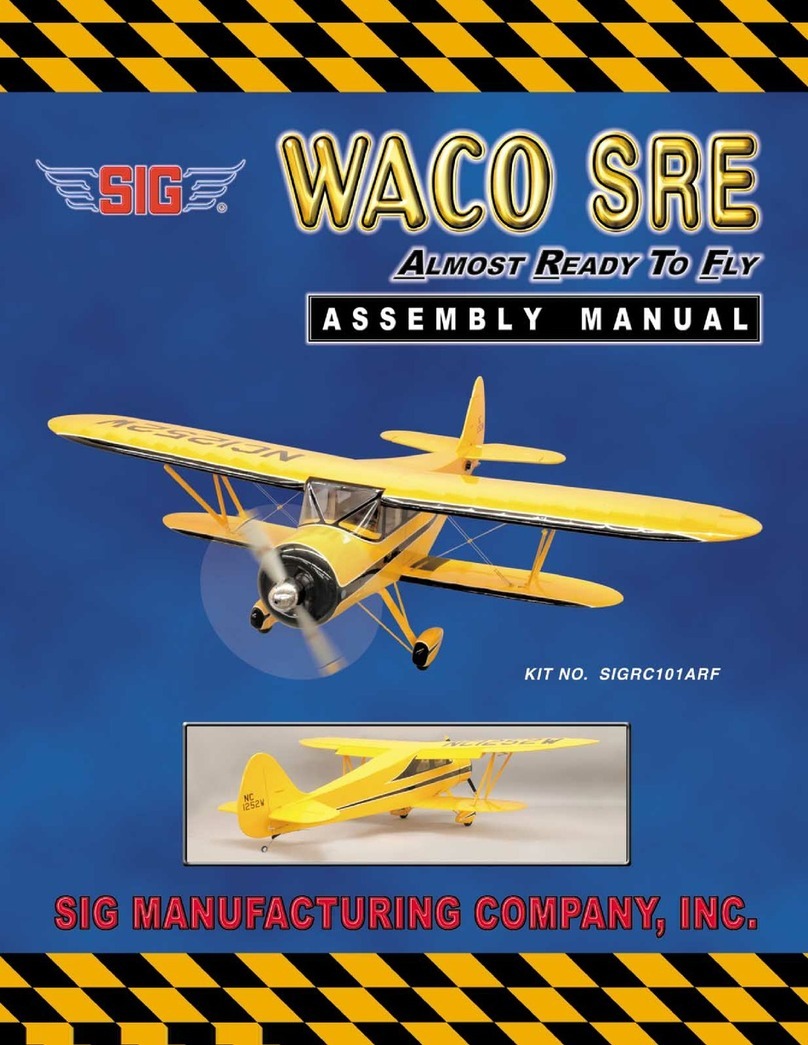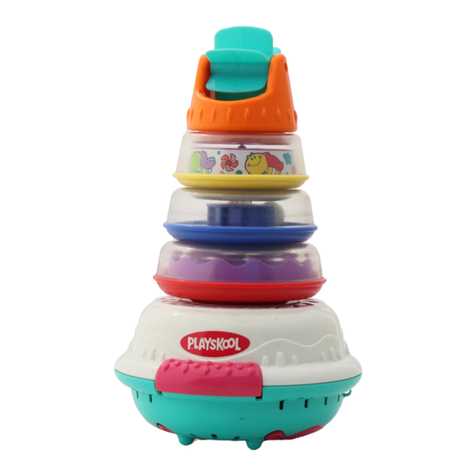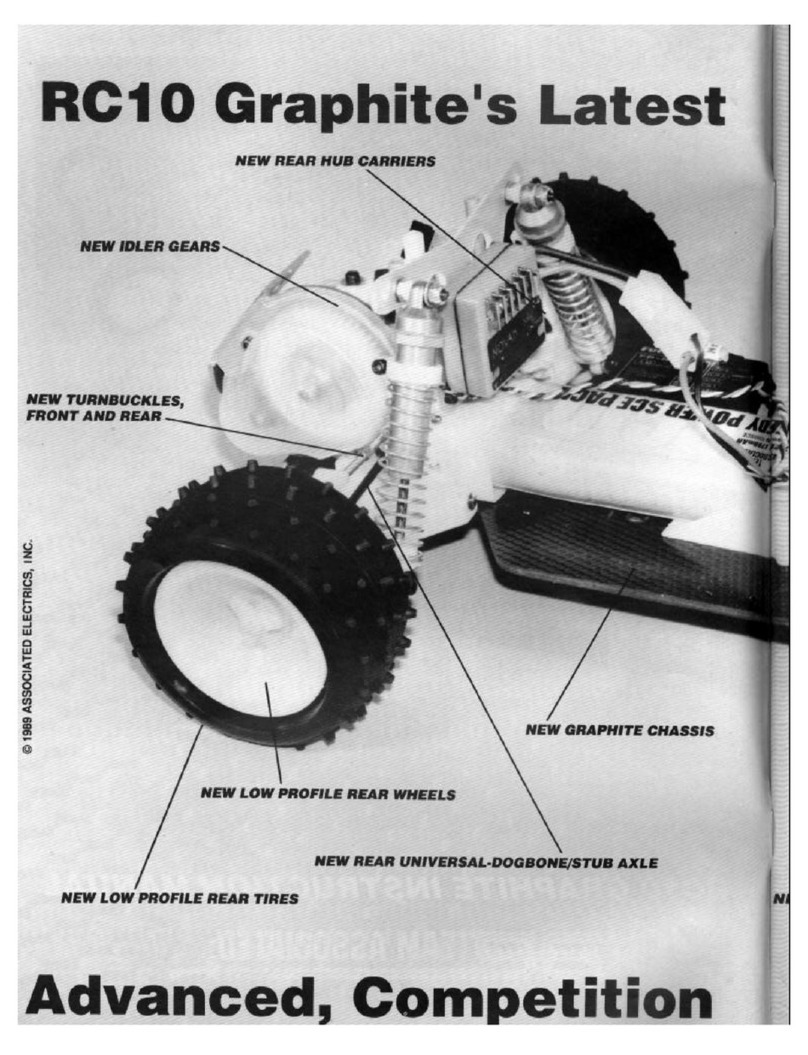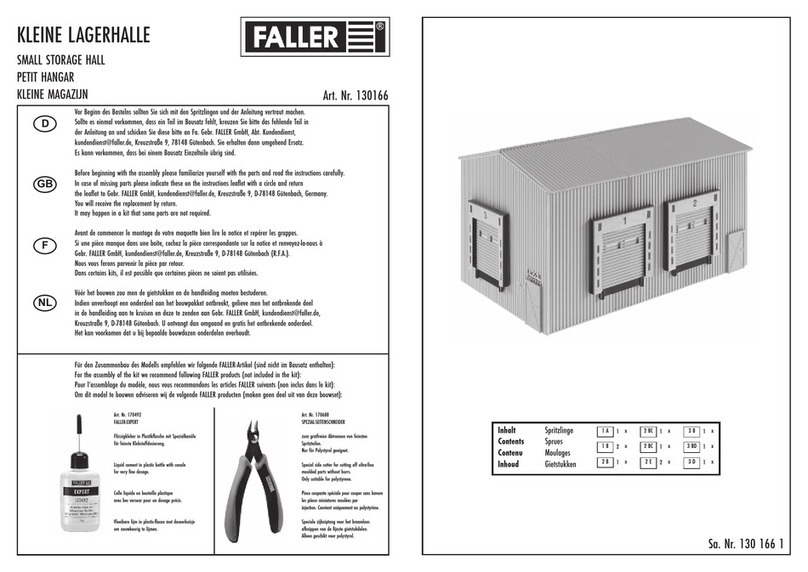Flex YAK54 User manual

Assembly Manual
5
4
The Original
35cc

INTRODUCTION
Congratulaons on the selecon of your new Premier AircraQQ Yak 54 35cc.
Designed by Quique Somenzini, Flex Innovaons co-founder and world
aerobac champion, this airplane is designed to excel in both precision and 3D
aerobacs. Strict aenon to structural and aerodynamic design details make
the QQ Yak 54 a very special airplane that's sure to give you a lot of sasfacon.
Flex Innovaons, Inc. and Premier Aircrathank you for your purchase...enjoy!
USING THIS MANUAL
This manual is divided into secons to make the assembly of the airplane easier
to follow. Note the boxes ( ) next to each step to help you keep track of the
steps that have been completed.
ATTENTION
The following terms are used throughout the product literature to indicate
various levels of potenal harm when operang the product.
Read the ENTIRE instrucon manual to become familiar with the features of
the product before operang. Failure to assemble or operate the product
correctly can result in damage to the product, personal property, and cause
serious or fatal injury.
All instrucons, warranes and other collateral documents are subject to
change at the sole discreon of Flex Innovaons, Inc. For up-to-date product
literature, please visit our website at www.exinnovaons.com and click on
the support tab for this product.
NOTICE: Procedures, which if not properly followed, create a possibility of
physical property damage AND a lile or no possibility of injury.
WARNING: Procedures, which if not properly followed, create the probability
of property damage, collateral damage, and serious injury OR
create a high probability of serious injury.
CAUTION: Procedures, which if not properly followed, create a probability of
physical property damage AND a possibility of serious injury.
1
WARNING
!
SPECIAL LANGUAGE DEFINITIONS
IMPORTANT INFORMATION REGARDING WARRANTY
Please read our Warranty and Liability secon before building this product. If
you as the Purchaser or user are not prepared to accept the liability associated
with the use of this product, you are advised to return this product
immediately in new and unused condion (in the original packaging) to the
place of purchase
SAFETY WARNINGS AND PRECAUTIONS
Protect yourself and others by following these basic safety guidelines.
This manual contains instrucons for safety, operaon and maintenance. It
is essenal to read and follow all the instrucons and warnings in the
manual, prior to assembly, setup or use, in order to operate correctly and
avoid damage or serious injury.
1.
2. In some cases, the wrien instrucons may dier slightly from the photos.
In those instances, the wrien instrucons should be considered correct.
3. This model is not a toy, rather it is a sophiscated hobby product and must
be operated with cauon and common sense. This product requires some
basic mechanical ability. Failure to operate this product in a safe and
responsible manner could result in injury, or damage to the product, or
other property.
4. This model must be assembled according to these instrucons. Do not alter
or modify the model outside of these instrucons provided by Flex
Innovaons, Inc, as doing so may render it unsafe and/or unyable. You
must take me to build straight, true and strong. It is your responsibility to
ensure the air worthiness of this product.
5. Use only compable, appropriate components for the nal assembly of this
model. Ensure that the radio system is in funconal condion, that the
engine is appropriately sized for the model, and that all other components
are appropriate for use in this model as specied in this instrucon manual.
All components must be installed correctly such that they operate correctly
both on the ground and in the air.
6. Inspect and check operaon of the model and all its components before
every ight.
7. If you are not an experienced pilot, or have not own a high-performance
model before, it is recommended that you seek assistance from an
experienced pilot in your R/C club for your rst ights. If you're not a
member of a club, the Academy of Model Aeronaucs (AMA) has
informaon about clubs in your area whose membership includes
experienced pilots.
8. Keep the propeller area clear from such items as loose clothing, jewelry,
long hair, or tools, as they can become entangled. Keep your hands and
body parts away from the propeller as injury can occur.
This product is not intended for use by children under 14 years without direct
adult supervision.

TABLE OF CONTENTS
Introducon .......................................................
Using this Manual ..............................................
Special Language Denions .............................
Warranty Noce .................................................
Safety Warnings and Precauons ......................
Kit Contents .......................................................
Specicaons .....................................................
Compleon Items ..............................................
Recommended Compleon Items .....................
Hangar 9 UltraCote/Oracover Colors ...............
Required Tools ...................................................
Required Adhesives ...........................................
Hardware Legend ...............................................
Assembly Symbol Legend ..................................
Before Starng Assembly ...................................
Aileron Hinging and Control Horn Installaon ...
Aileron Servo/Linkage Installaon .....................
Elevator/Rudder Control Horn Installaon .......
Elevator/Rudder Hinging ...................................
Elevator/Rudder Servo Installaon ....................
Landing Gear Installaon ...................................
Fuel Tank Tray Assembly ....................................
1
1
1
1
1
2
2
2
3
3
3
3
3
4
4
4-6
6-7
8
8-11
11-13
13-14
15-16
Gasoline Engine Installaon .............................
Electric Motor Installaon .................................
Cowling Installaon ...........................................
Shark Teeth Installaon ....................................
Field Assembly ..................................................
Center of Gravity ..............................................
Decal Installaon ..............................................
Aura 8 Setup .....................................................
Radio Setup/Range Test/Before First Flight ......
Replacement/Oponal Parts ............................
Limited Warranty ..............................................
AMA Safety Code ..............................................
Building and Flying Notes .................................
17-19
19-20
20-21
22
23
24
25
26
27
28
29
30
31-32
X
Y
Z
12.5-12.8 lb (5.67-5.80kg)
1100 sq. in (71 sq. dm.)
RECOMMENDED COMPLETION ITEMS
6+ channel transmier with
adjustable dual rates/mixing
Desert AircraDA-35
Potenza 200 Electric Motor
2 x 1300mAh Li-Po (Receiver)
1 x 1300mAh Li-Po (Ignion)
12S 3300-4200mAh Li-Po (Electric)
Gas - 6 x Potenza DS22209HV
Potenza (FPZC0080)
30-40cc Gasoline (Petrol) Engine
3000-3500W Electric Motor w/ 80A HV ESC
Gas - Falcon Carbon Fiber 20x8
Electric - APC 20x11, Falcon EP 21x10
See your engine manufacturer's manual for
recommendaons on your parcular engine.
(6) High Torque Digital Servos
200+ oz/in (14.4+ kg/cm)
Mul-Chemistry LiPo Balancing Charger
*weight may vary due to producon
tolerances and gear selecon.
76 in. (1930mm)
74 in (1880mm)
Aura 8 AFCS (FPZAURA08)
3-Axis Gyro with Sck Priority
KIT CONTENTS
2
Electric - 5 x Potenza DS22209HV
(5) High Torque Digital Servos
200+ oz/in (14.4+ kg/cm)

NEEDED TO FINISH
In addion to the airframe, there are addional
components required to nish the aircra. Reference
the list below, and note our recommendaons.
Setup 2: Electric Power
(1) 200-Size Electric Motor
Potenza 200 (FPZM10200A)
(1) 120-Amp High-Voltage ESC (No BEC)
Castle Creaons Phoenix Edge 80HV
(FPZPHXEDGE80HV)
(2) 6S 3500-4200mah 30C+ Li-Pos (in series for 12S)
Potenza 6S 4200mAh 40C Li-Pos (FPZB42006S40)
(1) Propeller for your motor/esc (consult your motor
and/or ESC manufacturer)
APC 20x11
(1) 12-inch (305mm) Heavy duty Servo Extension (ESC)
Both Setups:
(2) 1300mAh Li-Po Receiver Baery
Potenza 2S 1300mAh Li-Po (FPZBR13002S25)
(1) 3-3/4-inch Spinner
Tru-Turn® 3-3/4-inch P-51-Style Aluminum Spinner
(2) 24-inch (610mm) Heavy-Duty Servo Extensions
(Elevator)
(2) 6-inch (150mm) Heavy-Duty Servo Extensions
(Aileron, Inside Wings)
(2) 3-inch (76mm) Heavy-Duty Servo Extensions
(Receiver to Aileron)
(2) 1-3/4-inch (radius) Single Servo Arms (2-aileron)
Potenza 25T 1.75-inch Single Servo Arm (FPZA0003)
(1) 1-1/2-inch (radius) Double Servo Arm (Rudder)
Potenza 25T 1.5-inch Double Servo Arm (FPZA0004)
(2) 1-1/4-inch (radius) Single Servo Arms (2-elevator)
Potenza 25T 1.25-inch Single Servo Arm (FPZA0001)
HANGAR 9® ULTRACOTE®/ORACOVER® COLORS
In the unfortunate event that your Mamba requires repair aer a mishap, please reference the codes below for the
appropriate color to repair your covering. UltraCote® will be the most commonly available brand in North and South
America, and Oracover® will be most prevalent in Europe and the rest of the world.
Hangar 9® UltraCote® Oracover®
HANU872
HANU873
HANU866
HANU870
Bright Yellow
Deep Blue
True Red
White
33
50
23
10
Cadmium Yellow
Blue
Ferrari Red
White
REQUIRED TOOLS FOR ASSEMBLY
Epoxy Brushes/Mixing Cups/Scks
Isopropyl Alcohol (91%)
Needle-Nosed Pliers
Petroleum Jelly
Ruler
Low-Tack Masking Tape
Felt-Tipped Pen
Hex Wrench (2.5, 3, 4mm)
Light Machine Oil
Nut Drivers (5.5, 8mm)
Phillips Screwdriver (#1)
Tie Wraps (4-inch)
Hook & Loop Straps/Tape
Flat File
Hobby Knife with #11 Blade
REQUIRED ADHESIVES FOR ASSEMBLY
Thin CA 30-minute Epoxy Blue Thread Lock
HARDWARE IDENTIFICATION LEGEND
Rigging Coupler
Socket Head Cap Screw
Flat Washer Nylon Insert Lock Nut Hex Nut Wheel Collar
Ball Link
Self Tapping Screw
Quick Connect Wire Crimp
Machine Screw
3
Toothpicks
Paper Towels
Setup 1: Gasoline (Petrol)
(1) 30-40cc Gasoline (Petrol) Engine
Desert AircraDA-35
(1) Exhaust (consult your engine manufacturer)
Desert AircraDA-35 Standard Muers
(1) Propeller for your engine (consult with engine
manufacturer)
Falcon Carbon Fiber 20x8 (FPMPFC2008)
(1) 1300mAh Li-Po Ignion baery
(consult your engine manufacturer)
Potenza 2S 1300mAh 25C Li-Po (FPZBR13002S25)
(1) Choke Servo (Oponal)
Potenza DS22209 Digital Servo (FPZDS22209)
(1) 6-inch (150mm) Heavy Duty Servo Extension
(Choke)
(1) Throle Servo
Potenza DS22209 Digital Servo (FPZDS22209)
(1) 3-inch (76mm) Heavy Duty Servo Extension
(Throle)
(1) 3 feet (1 meter) Gas Fuel Tubing (large diameter)
Rubber O-Ring
Flange Nut
Spring Washer

ASSEMBLY SYMBOL LEGEND
Mark Test Fit Fully Tighten Clamp Cut with
#11 Blade
Drill
Apply
Threadlocker
Use
Thin CA
Use
Medium CA
Use 5
Minute
Epoxy
Use 15
Minute
Epoxy
Use 30
Minute
Epoxy
Apply
Light Oil
Duplicate
Assembly
Ensure
Free
Rotaon
Mirror
Assembly
IMPORTANT BEFORE STARTING ASSEMBLY
Organizaon is key to building a successful, well-built, good-ying model. Please take a
few moments to follow these next few steps to ensure you are geng the most out of
your Yak 54, and ensure that it will be in your stable for a long me to come.
1.
2.
4.
Remove all parts from their plasc bags, inventory all items and closely
examine all of the major airframe components for damage. If any items are
missing, or you nd damaged components, please contact customer support.
Use a covering iron with a covering sock on high heat to ghten the covering
as necessary, paying special aenon to the leading edges of the ying
surfaces, hinge lines and stabilizer and wing saddle areas. Apply slight
pressure over sheeted areas to thoroughly bond the covering to the wood.
Use cauon around seams to prevent inadvertently pulling them loose.
Gather all required components such as motor and radio equipment that will
be used to equip the airplane. Create a new radio program in your transmier
and bind this model program to the receiver that will be used in the airplane.
3. Use thin CA to go over any important glue joints, such as the motor box,
rewall, servo mounng rails, and any other pre-assembled joints that may
see high stress during ight.
AILERON HINGING AND AILERON CONTROL HORN INSTALLATION
Required Components
Main Wings (x2)
Control Horns (x4)
Required Adhesives
30-Minute Epoxy (Or other hinge-type glue)
Ailerons (x2) Aileron Hinges (x12)
Required Tools/Building Materials
Low-Tack Masking Tape
Petroleum Jelly
Epoxy Mixing Cups/Scks
Toothpicks (oponal)
1.
In order to help prevent scratches on your new model, it is always best to work with
the parts on a sosurface, like packing foam or felt.
HELPFUL HINT
Prepare the aileron hinges by scung the area that will be inserted into the
wing or ying surface with medium grit sand paper. Be careful not to remove
too much material. Use isopropyl alchol, and a paper towel to remove any
excess debris that remains on the hinges.
Medium Grit Sand Paper
Isopropyl Alcohol (91%)
Paper Towels
Test t the hinges into the ailerons, and then the hinges into the wings.
Ensure that the hinge pockets line up, and that the hinges move freely.
2.
4

Using a toothpick or coon swab, apply a small amount of petroleum jelly to
the pivot of each hinge. Do not apply petroleum jelly to the enre hinge.
3.
5
WARNING
!
Petroleum jelly prevents glue adhesion. Do not apply petroleum jelly to the surface
areas of the hinge that require glue adhesion to the wing or surface.
Mix a sucient amount of 30-minute epoxy in a cup, and with a toothpick,
smear epoxy in the hinge pockets of the wing panel and aileron. Slowly and
carefully, insert each hinge into the wing panel. Parally remove and reinstall
the hinge to ensure that you've completely coated it with glue. Clean up any
excess epoxy with isopropyl alcohol, and tape the aileron in place to cure.
4.
6.
Locate the control horn slots in the ailerons, remove the covering from the slots
with a #11 hobby knife. Check the t of the control horns in the slots of the
ailerons. Make any adjustments necessary at this me.
WARNING
5.
Prepare the aileron control horns by sanding the secon that extends into the
control surface with medium grit sand paper. Use isopropyl alcohol and a paper
towel to remove any excess debris from the control horn.
If not properly scued, glue may not adhere to the control horn, resulng in a failure.
NOTICE
*Note - Picture of dierent model parts shown
*Note - Picture of dierent model shown

6
Mix a sufficient amount of 30-minute epoxy in a cup, and with a toothpick,
apply epoxy in the control horn slots in the aileron. Slowly and carefully,
insert each control horn into the aileron. Par�ally remove and reinstall the
control horn to ensure that you've completely coated it with glue. Before the
epoxy has fully cured, remove the tape, and clean up any excess epoxy with a
paper towel and isopropyl alcohol.
8.
7.
Once sa�sfied with the fit of the control horns, apply low-tack tape
approximately 1/32-inch (1mm) around the control horns. This will help keep
epoxy offof the surface of the ailerons. Once the tape has been applied,
remove the control horns.
AILERON SERVO AND LINKAGE INSTALLATION
Required Components
Main Wing (x2)
Aileron Linkage, 65mm (x2)
M3 Lock Nut (x4)
Aileron Servo (x2)
Ball Links (x4)
M3 Washer (x4)
6-Inch (150mm) Extension (x2)
Aileron Servo Arm (x2)
M3x12 SHCS (x4)
Required Tools/Building Materials
#1 Phillips Screwdriver
Thread or Shrink Tube
1.
2.
Use a #1 Phillips screwdriver to thread a servo moun�ng scre
w into each of the
pre-cut holes in the servo moun�ng rails in the wing. Remove the screw, and
apply a small amount of thin CA to each of the holes to harden the threads cut
by the screw. Let the CA fully cure before proceeding.
Required Adhesives
Thin CA Blue Thread Lock
Ball Driver: 2.5mm Nut Driver: 5.5mm
*Note - Picture of different model parts shown
Secure a 6-inch (150mm) servo extension to the aileron servo. Use thread,
tape, or shrink tube to keep the connec�on secure.

7
3.
Insert the aileron servo into the servo bay with the output sh
atowards the
leading edge of the wing. Be sure to route the servo lead out of the wing
before mounng the servo to avoid pinching any wiring. Mount the servo to
the wing using a #1 Phillips screwdriver and the screws provided with your
servo.
4.
Center the servo using your radio system. Install a 1-3/4-inch (45mm) servo
arm onto the servo. Apply a small drop of blue thread lock onto the servo
arm screw, and fully ghten the screw. Be sure to avoid geng thread lock
compound into the servo gears.
5.
Using a pushrod of 2-9/16-inch (65mm) length, assemble th
e aileron
linkages so that the total length from center of ball to center of ball is
approximately 3-3/16-inches (81mm). Final length will be adjusted when
centering the control surface.
6.
Aach the linkage to the servo arm. The order of compone
nts starng
AWAY from the wing is as follows:
- M3x12 Socket Head Cap Screw
- M3 Washer
- Ball Link
- Servo Arm
- M3 Washer
- M3 Lock Nut
With the radio powered on, and the servo centered with the arm parallel to
the hinge line, adjust the linkage length so that the control surface is
centered. Aach the linkage to the control horn in the following order:
- M3x12 Socket Head Cap Screw
- M3 Washer
- Control Horn
- Ball Link
- Control Horn
- M3 Washer
- M3 Lock Nut
Ball Link (2)
3-3/16-inches (81mm)
M3x12 (2)
M3 (2)
*Note: Drawing not to scale
M3 (4)
AILERON LINKAGE

8
ELEVATOR/RUDDER CONTROL HORN INSTALLATION
Required Components
Rudder
Elevator Control Horns (x2)
Elevator (x2) Rudder Control Horns (x2)
Required Tools/Building Materials
Low-Tack Tape
1.
Required Adhesives
30-Minute Epoxy
Isopropyl Alcohol Paper Towels
2.
3.
Test t the control horns in their corresponding slots. Make any adjustments
necessary to the slots at this me. Once sased with the t of the control
horns, apply low-tack tape approximately 1/32-inch (1mm) away from the
control horns. For the rudder pull-pull setup, but sure to do this to both sides
of the rudder. Aer applying low-tack tape, remove the control horns from the
slots.
Prepare the control horns by sanding the secon that extends into the control
surface with medium grit sand paper. Use isopropyl alcohol and a paper towel
to remove any excess debris from the control horn.
If not properly scued, glue may not adhere to the control horn, resulng in a failure.
NOTICE
Mix a sucient amount of 30-minute epoxy in a cup, and with a toothpick,
apply epoxy in the control horn slots. Slowly and carefully, insert each control
horn into the surfaces. Parally remove and reinstall the control horn to
ensure that you've completely coated it with glue. Before the epoxy has fully
cured, remove the tape, and clean up any excess epoxy with a paper towel
and isopropyl alcohol.
RUDDER & ELEVATOR INSTALLATION
Required Components
Fuselage (canopy removed)
Elevator Hinges (x8)
Tail Wheel Bracket
Horizontal Stabilizers (L&R)
Rudder
Tail Wheel Wire
Elevator Halves (L&R)
Rudder Hinges (3)
Tail Wheel
Required Tools/Building Materials
Epoxy Mixing Cups/Scks
Low-Tack Masking Tape
Required Adhesives
30-Minute Epoxy
Isopropyl Alcohol
Toothpicks
Paper Towels
1.
Test t the hinges into the elevators and horizontal stabilizers. Ensure that
the hinge pockets line up, and that the hinges move freely.

9
Prepare the hinges by scuffing the area that will be inserted into the wing or
flying surface with medium grit sand paper. Be careful not to remove too much
material. Use isopropyl alchol, and a paper towel to remove any excess debris
that remains on the hinges.
2.
If not properly scuffed, glue may not adhere to the hinges, resul�ng in a failure.
NOTICE
3.
Mix a sufficient amount of 30-minute epoxy in a cup, and with a toothpick,
smear epoxy in the hinge pockets of the horizontal stabilizer and elevator.
Slowly and carefully, insert each hinge into the stabilizer and elevator. Par�ally
remove and reinstall the hinge to ensure that you've completely coated them
with glue. Be sure the hinges are oriented so that the elevators can move
properly. Clean up any excess epoxy with isopropyl alcohol, and tape the
elevator in place. Set the horizontal stabilizers aside to cure.
4.
Prepare the tailwheel wire by scuffing the "L" shape bend side of the wire with
medium grit sand paper. This is done to promote glue adhesion when hinging
the rudder.
5.
The tail wheel bracket has 3 holes. 2 are slightly closer together. Assemble the
tail wheel wire and bracket by sliding the bracket over the "L" bent side of the
wire, using the hole furthest away from the other two in the bracket. This hole
is just large enough to fit the wire through it. It may be snug, but do not drill
out this hole, as it is important to keep this tolerance �ght for proper longevity
of your bracket.
6.
Use a file to make two small flat spots on the inside and outside of the tail
wheel wire for the lock collar set screws.

10
7.
Finish the tail wheel bracket assembly by sliding a M2 lock collar onto the tail
wheel axle with the ange facing the center of the axle. Apply a drop of light
oil on the axle, and slide the wheel onto the axle. Install another M3 lock
collar, with the ange facing the wheel. Apply blue thread lock to the set
screws, ghten them into the lock collars, and on to the at spots created in
the previous step. Be sure the tail wheel rotates freely.
M2 (2)
9.
Place a washer over an M3x15 machine screw, and apply a drop of blue thread
lock. Fully ghten the screw into the blind nut in the boom of the fuselage.
M3x15 (2)
M3 (2)
Test t the rudder hinges and tail wheel wire in the rudder and vercal n.
Make sure all of the hinge slots line up, and that the rudder can move freely.
Adjust as needed. Once sased with the t, remove the rudder and the
hinges from the aircra.
Use medium grit sandpaper to prepare the hinges for installaon. Remove any
excess debris with a paper towel and isopropyl alcohol. Apply petroleum jelly
to the hinge points at this me. This can be applied in the same manner that
was used for the elevator and aileron hinges.
WARNING
!
Petroleum jelly prevents glue adhesion. Do not apply petroleum jelly to the surface
areas of the hinge that require glue adhesion to the wing or surface.
11.
10.

11
12.
Mix a sucient amount of 30-minute epoxy in a cup, and with a toothpick,
apply epoxy in the rudder hinge and tail wheel slots. Slowly and carefully,
insert each hinge into the slots. Parally remove and re-install the hinges and
tail wheel wire to ensure that you've completely coated it with glue. Before
the epoxy has fully cured, tape the rudder to the vercal stabilizer, and clean
up any excess epoxy with a paper towel and isopropyl alcohol.
ELEVATOR/RUDDER SERVO INSTALLATION
Required Components
Fuselage
Elevator Linkage, 116mm (x2)
M3 Lock Nuts (x8)
M3x10 SHCS (x4)
Elevator Servo (x2)
Rudder Pull-Pull Cable
M3 Washers (x20)
24-inch (610mm) Extension (x2)
Rudder Servo
Rigging Couplers
M3x12 SHCS (x8)
Wire Crimp (x4)
Required Tools/Building Materials
#1 Phillips Screwdriver
Thread or Shrink Tube
Required Adhesives
Thin CA Blue Thread Locker
Ball Driver: 2.5mm
Needle-Nosed Pliers Nut Driver: 5.5mm
1.
Follow the same steps for installing the aileron servo to install the elevator
servo. Secure an 24-inch (610mm) extension to the servo. Route the extension
through the guides in the fuselage and install the elevator servo with the
output shafacing the NOSE of the aircra. Do not install the servo arm at this
me.
2.
Insert the horizontal stabilizer tube into one horizontal stabilizer half. Insert
the tube into the fuselage, and secure the horizontal stab to the fuselage with
two M3x10 socket head cap screws and two M3 washers. If you will be leaving
the horizontal stabilizers installed all the me, add a small drop of blue thread
lock to each of the horizontal stabilizer screws.
M3x10 (2)
M3 (2)
3.
Assemble the elevator linkage in the same manner as the aileron linkage
using a 4-9/16-inch (116mm) linkage. Run the pushrod into each ball link
approximately halfway.
Once assembled, make a small bend approximately 1-9/16-inch (40mm)
from the center of one linkage. Reference the diagram above.
The nal length of the linkage from center of link to center of link (including
the bend) should be approximately 1-3/16-inches (132mm). Aach the
linkage to the control horn using the same order of hardware as the aileron
linkages (reference page 7).
**Note: Drawing not to scale
Ball Link (2)
M3x12 (2)
M3 (2)
M3 (4)
13/32-inch
(10mm)
1-3/16-inches (132mm)
Servo Side
Control Horn Side

12
4.
Center the elevator servo and install the servo arm onto the servo. Note that
the linkage length provided above should be extremely close, and the servo
arm should an
gle slightly towards the tail. Verify the servo travels as needed
and that the linkage does not interfere with the movement of the surface.
Reference the pictures above.
Note any interference and
adjust bend as needed
4.
Install the rudder servo in the rudder tray inside the fuselage. Be sure to
orient the servo with the output shatowards the tail of the airplane. Center
the servo with your radio system and install a 3-inch double servo arm so that
it is perpindicular to the servo case. Use as lile electronic trim as possible. If
you are using the Aura 8, this should be done in the Aura Cong Tool. Apply a
drop of blue thread lock to the threads of the servo arm screw, and secure it
in place..
5.
Using pliers, thread a rigging coupler approximately halfway into a ball link.
Ball Link (2)
Rigging
Coupler (2)
You can take a ruler and felt-pped marker to mark the center of the threads on the
rigging coupler. Once the end of the ball link reaches the mark you made on the
threads, you know the rigging coupler has sucient thread depth into the ball link.
HELPFUL HINT

13
6.
Aach the ball link to the rudder control horn and servo arm using a 2.5mm
ball driver and a 5.5mm nut driver or pliers. Use the same order of
components as listed on page 7.
M3x12 (4)
M3 (4)
M3 (8)
Thread the pull-pull cable through a wire crimp, then through the rigging
coupler and back through the crimp. For extra security, you can loop the wire
back through the crimp a third me. Use a crimping tool to crimp the pull-pull
cables.
Route the cables through the hole in the side of the fuselage, and up to the
servo rigging couplers. Note that the pull-pull cables should cross inside the
fuselage. Be sure that the cables are routed so that they are free from any
interference in the fuselage. Thread the pull-pull cable through a wire crimp,
then through the servo arm rigging coupler and back through the crimp.
Tighten the cable while being sure that the rudder is centered, and use a
crimping tool to crimp the pull-pull cable.
7.
Wire
Crimp (4)
LANDING GEAR INSTALLATION
Required Components
Fuselage Assembly
Main Wheel (2)
M3 Flat Washer (4)
M4 x 20 Screw (4)
M4 Lock Collar
Carbon Fiber Gear (Oponal)
M3 x 12 Screw (4)
M8 Lock Nut (2)
M4 Lock Nut (4)
Required Tools/Building Materials
Ball Driver: 2.5mm
Open-End Wrench: 13mm
1.
NOTE:
Assemble the axle to the landing gear leg using two 13mm open-end
wrenches. Fully ghten at this me.
Nut Driver: 8mm
Felt-Tipped Pen
Flat File
Aluminum Landing Gear
Axle (2)
M8 Flat Washer (2)
M4 Flat Washer (4)
Wheel Pant (R&L)
M3x12 (2)
M3 (2)
Required Adhesives
Blue Thread Lock
2.
Temporarily slide a main wheel onto the axle, and aach the wheel pant in
place using two M3x12 screws and two M3 at washers. Center the wheel in
the wheel pant, and mark the sides of the wheel on the axle with a felt-pped
pen. Remove the wheel pant and wheel.
Note: This is also a good me to verify proper clearance of the wheel and
wheel pant. We recommend opening the wheel pant with a rotary tool and
sanding drum so that your wheel has similar clearance as in the photo above.
M5 (1)
M5 (1)
Op�onal carbon fiber landing gear is available for purchase
seperately. Switching to carbon landing gear saves approximately 3
ounces (85g) in weight.

14
3.
Use a at le to make two at spots on the axle where th
e marks were made
in step 2.
4.
Slide an M4 wheel collar onto the axle with the ange aw
ay from the landing
gear. Use blue thread lock on the set screw, and ghten the wheel collar down
on the at spot made in the previous step. Slide a main wheel onto the axle,
followed by a second wheel collar with the ange facing the wheel. Use blue
thread lock on the set screw, and ghten the wheel collar down against the
wheel. Ensure the wheel spins freely.
To install the wheel pants, place an M3 washer onto an M3x12 screw. Apply a
drop of blue thread lock on the screw, and run the screw through the landing
gear leg, threading into the blind nuts located in the wheel pant. Before fully
ghtening, start the second screw (with blue thread lock) for that wheel pant.
Now fully ghten both screws.
M4 (2)
In order to help reduce damage to your model while building, the wheel pants can
be installed last aer compleng the build.
HELPFUL HINT
M3x12 (2)
M3 (2)
5.
Remove the landing gear cover plate from the fuselage. Sit the landing gear on
the fuselage so that it sweeps forward as it moves away from the fuselage.
Place an M4x20 screw with an M4 washer through the landing gear cover, and
through the landing gear. Add a drop of blue thread lock to each of the screws.
Thread the screws into the aluminum landing gear plates mounted in the
fuselage. Use a 8mm nut driver to ghten an M4 lock nut onto the screw from
inside the fuselage. Repeat for the remaining 3 screws.
M4 (1)
M4x20 (1)
M4 (1)
Note angle of landing gear

15
1.
FUEL TANK TRAY ASSEMBLY
Required Components
Fuel Tank
Clunk
Stopper Back Plate
Throle Servo
Receiver Baery
3-inch Servo Extension
Throle Linkage
Fuel Line
Stopper Cap
Gas Tank Tray (Plywood)
Ignion Baery
Hook and Loop Strap (x2)
Shrink Tube or Thread
Required Tools/Building Materials
#1 Phillips Screwdriver
Brass Tubing (x2)
Fuel Stopper
Stopper Screw
Choke Servo (oponal)
Hook and Loop Tape
6-inch Servo Extension (oponal)
Choke Linkage (oponal)
Required Adhesives
Thin CA
If you are using an electric motor setup, you may skip ahead to page 19.
You must supply large diameter, high-quality fuel line for your fuel system, it
is not included with your aircra.
The fuel tank stopper comes parally assembled. Cut a small secon of fuel
line, and secure it to the straight brass tube on the back side of the stopper.
Secure the clunk to the other end of the line. Be sure that the clunk does not
touch the back of the tank when the tank is held vercally, and that there is
room for the fuel line to expand slightly when you rst put fuel in the tank.
Cut another small secon of fuel tubing, and secure it to the vent side of the
tank (the angled brass tube) as a small vent line extension. It may take some
test ng, but make sure the fuel line just reaches the top of the tank, but
does not touch it.
Once happy with the t of all fuel lines inside the tank, secure all fuel line to
the brass tubing and clunk using safety wire.
Blue Thread Lock
2.5mm Ball Driver
2.
Press the fuel stopper assembly into the fuel tank. Be sure that the the vent
side of the fuel line bends towards the top of the fuel tank. Note that this may
take a bit of force to seat the stopper assembly properly into the neck of the
tank. Once fully seated, ghten the phillips head stopper screw unl ght.
3.
Locate the plywood gas tray for the forward fuselage secon. Reference the
drawing above.
Note the angle on the front of the gas tray, and how it ts into the fuselage.
Apply hook and loop tape to the fuel tank, and the top of the fuel tank
locaon on the tray. Place the fuel tank onto the tray. Be sure to do this with
the tray in the proper upright posion. Secure the tank to the tray by
wrapping two hook and loop straps around the tank and tray.
FUEL TANK
Note Angle
Top View
4.
Prepare the throle servo by securing a 3-inch (76mm) servo extension to the
servo lead using shrink tube or thread. If you are using a servo-operated
choke, secure a 6-inch (153mm) servo extension to the choke servo.
Vent Extension
Fill Line

16
FUEL
TANK
Top View
5.
Thread a servo mounng screw into each of the mounng holes you plan to
use. Remove the screw, and apply thin CA to each of the holes. Let the CA
fully cure before proceeding.
Note, if using the DA-35, the throle servo is mounted on the LEFT side of
the tray, and the choke servo is mounted on the RIGHT side of the tray.
Install the throle servo inverted on the tray with the output shatowards
the REAR of the aircra. You may also center the servo, and install a servo
arm of approximately 1-inch (25mm) in length at this me.
Install the choke servo inverted on the tray, with the output shatowards
the REAR of the aircra. You can center the servo, and install a servo arm of
approximately 1-inch (25mm) in length at this me.
Be sure to use blue thread lock when securing the servo arm screws.
6.
You can mount your receiver baeries at this me. Note that due to variaons
in producon and equipment choices, you may need to move the baeries at
a later step to adjust the CG of your model.
Once nished, place the assembly aside for a later step. Do not install into the
fuselage at this me.
Choke
Throle
Secure the quick connector to your throle and choke (if using a s
ervo for
choke) servo arm. Be sure to use blue thread lock for a secure aachment. Be
sure the connector rotates freely aer it has been ghtened. The order of
components is as follows:
Quick connect housing
Washer
Servo Arm
Washer
Nut
Quick
Connect
(1)
**Note - dierent model shown
7.

17
3.
Locate the standos, M5x20 screws and M5 washers supplied with your
DA-35 engine. Place an M5 washer on the screw, and apply a drop of blue
thread lock to each screw. Hold the engine standoin place over one of the
holes in the rewall, and secure it in place with an M5 screw. Note that the
screw head and washer should be on the inside of the fuselage.
Motor Box
M5x20
M5x20
M5
M5
M5x15
M5x15
M5x20 (4)
M5 (4)
2.
Use a drill and 1/4-inch (6mm) drill bit to drill any needed holes marked from
the previous step. Note that these holes may need enlarged once you have
the linkage secured and operang with your servo(s).
GASOLINE ENGINE INSTALLATION
Required Components
Engine
Fuselage Assembly
M5x15 SHCS (x4)*
Choke Linkage
M3 Lock Nut (x2)
Ignion
M5x20 SHCS (x4)*
Throle Linkage
M3x15 SHCS (x2)
Required Tools/Building Materials
4mm Ball Driver
Drill
Exhaust
Standos*
M5 Flat Washer (x4)*
Ball Link (x2)
Required Adhesives
Blue Thread Lock
If you are using an electric motor setup, you may skip ahead to page 19.
Some hardware is provided with the (recommended) DA-35. If you are not using the DA-35, you may need to
supply similar hardware appropriate for your par�cular engine/manufacturer. The length from the firewall to
the back of the spinner should be approximately 162mm (6-3/8-inches). Use this informa�on to calculate the
length of standoffs you will need, and any associated hardware.
*NOTE:
2.5mm Ball Driver
1/4-inch (6mm) Drill Bit
Needle-Nosed Pliers
1.
Using the reference marks etched into the rewall of the fuselage, mark the
locaon for the throle linkage hole, for the DA-35. If you are using a dierent
engine, you may have to mount the engine, mark the locaon, and remove
the engine before proceeding.
Facing the rewall, the throle linkage hole is 23mm (29/32-inch) right of the
centerline, and 15mm (19/32-inch) below the centerline.
If you are using a servo-operated choke, mark its linkage locaon. It is 10mm
(13/32-inch) right of center, and 23mm (29/32-inch) below center.
Reference the diagram above.
15mm (19/32-inch)
23mm (29/32-inch)
Throle
Choke
23mm
(29/32-inch)
10mm
(13/32-inch)

18
8.
Note that you may need to connect the throle (and choke linkage if using
servo-operated choke) while installing the tray. Remove the hatch on the
boom side of the motor box. This will allow adequate room to install the
linkages. Remove the screw from the quick connect, and slide the linkage
through the hole. Install the fuel tank tray assembly into the fuselage using a
2.5mm hex driver, M3x12 screw, and M3 washer. Apply a drop of blue thread
lock to each screw, and fully ghten. Once the tray is fully secured in place,
you can nish seng up your throle (and choke) servo(s) at this me. Be
sure to apply blue thread lock to the quick connect screw when securing it in
its permanent locaon.
7.
Connect your throle and choke linkages to the throle and choke arms on
the engine. If using the DA-35, it is recommended that you replace the 2
M3x15 screws and M3 lock nuts with 4-40 x 1/2-inch screws and #4 lock nuts.
The recommended choke setup for the DA-35 is shown in the image above.
This method is easy to install, and easy to actuate through the front of the
cowl. This method also saves a signicant amount of weight, complexity, and
cost by avoiding the use of another servo. Note that you may need to rotate
the choke arm on the engine to allow proper hand-actuaon of the choke
lever. If you do move the choke arm on the engine, be sure to secure it with
blue thread lock. Once the choke arm is rotated in the proper direcon,
secure the choke linkage to the choke arm, and use a medium-sized cable e
to securely fasten the choke linkage to the stando. Be sure that the cable e
is not too ght, and has free operaon of the choke linkage, while not being
too loose and allowing the choke linkage to vibrate.
M3x15 (2)
M3 (2)
M3x12 (6)
M3 (6)
**Note - Electric tray shown for clarity
4.
Connect any fuel lines as needed to your engine, and use an M5x15 screw to
secure the engine to the standos. Be sure to apply blue thread lock to the
screws.
You can install your fuel dot or ller method of choice at this me.
Motor Box
M5x20
M5x20
M5
M5
M5x15
M5x15
M5x15 (4)
5.
Locate your throle and choke linkages. These are the longest linkages
included with your kit, and are only threaded on one side. Thread a ball link
onto the end of each linkage approximately halfway.
6.
The throle linkage requires some bends to operate properly. Bend the
linkage as shown in the image above. Further bends may be required when
you nish assembly with the servo actuang the throle.
Bend your choke linkage as needed for proper actuaon of the choke
buery.

19
ELECTRIC MOTOR AND ESC INSTALLATION
Required Components
Motor
Fuselage Assembly
M5x12 SHCS (x4)
M5 Spring Washer (x4)
Electric Motor Box
M5x15 SHCS (x4)
M5 Lock Nut (x4)
Required Tools/Building Materials
4mm Ball Driver
Electronic Speed Controller
12-inch Servo Extension
M5 Flat Washer (x8)
Required Adhesives
Blue Thread Lock
If you are using an gas engine setup, you may skip ahead to page 20.
8mm Nut Driver
1.
8.
You can install your ignion, ignion baery and ignion switch at this me.
Note that there are pre-cut switch locaons in both sides of the forward
fuselage sheeng.
Use a 4mm ball driver, 8mm Nut Driver, (4) M5x15 screws, (4) M5 washers,
and (4) M5 lock nuts to secure the electric motor box to the main rewall of
the fuselage. Be sure to use blue thread lock when securing the screws. Note
that the electric box is square, but the screws are not centered. When
installing, make sure the boom of the motor box is ush with the boom of
the electric motor box. If it is not ush, rotate 180 degrees and re-install.
M5x15 (4)
M5 (4)
M5 (4)
Table of contents
Other Flex Toy manuals
Popular Toy manuals by other brands

Startright
Startright Barney i love music laptop User instruction guide
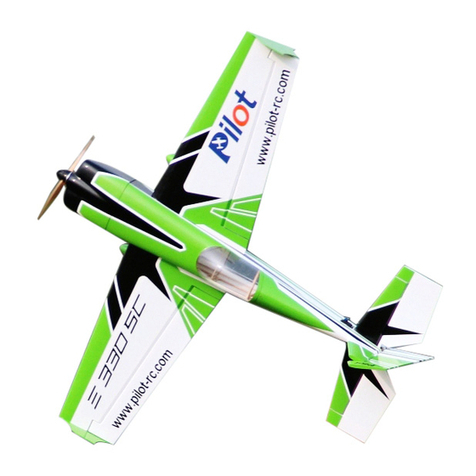
Pilot RC
Pilot RC Extra 330SC user manual
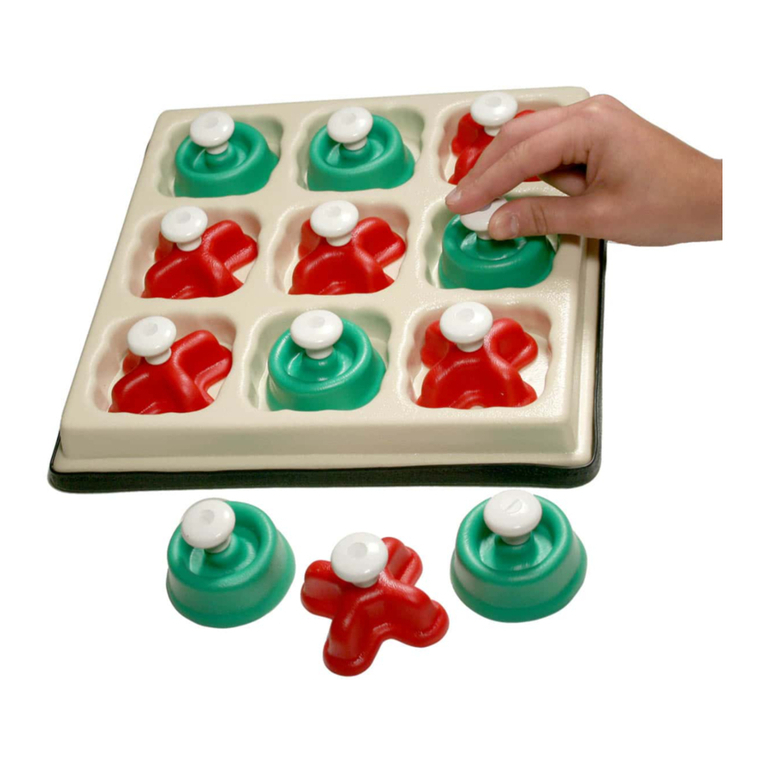
Enabling Devices
Enabling Devices Tic Tac Toe user guide

Mattel
Mattel DC Super Hero GIRLS instructions
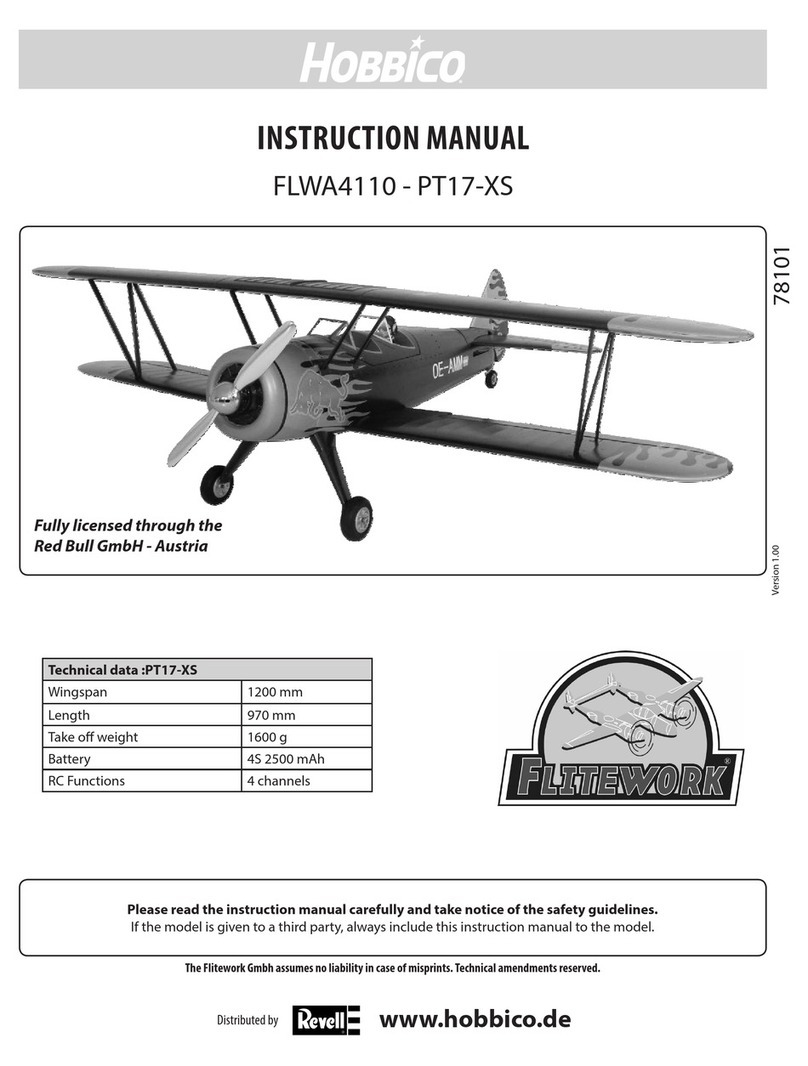
Hobbico
Hobbico FLWA4110 - PT17-XS instruction manual

K'Nex Education
K'Nex Education K-8 manual
